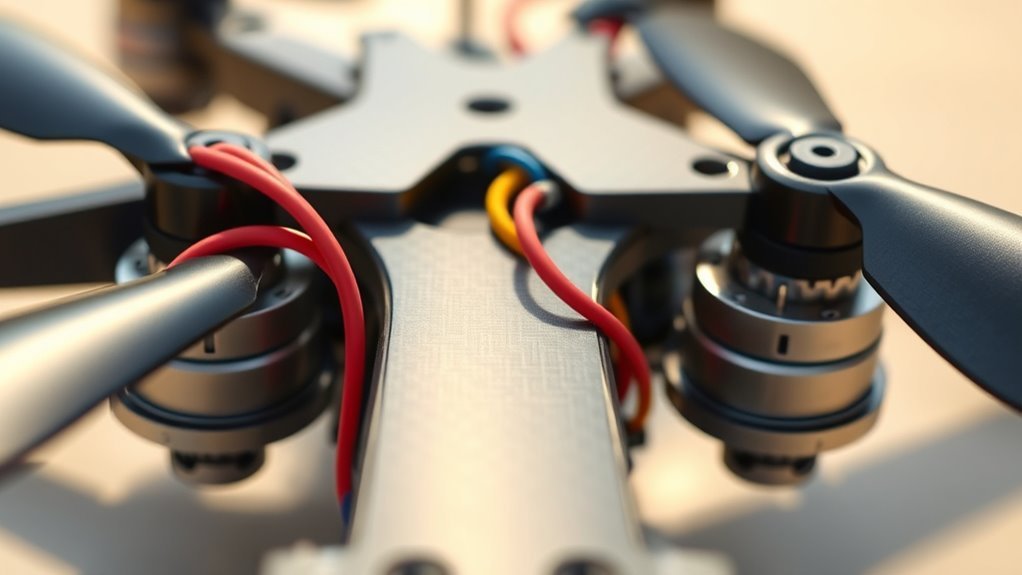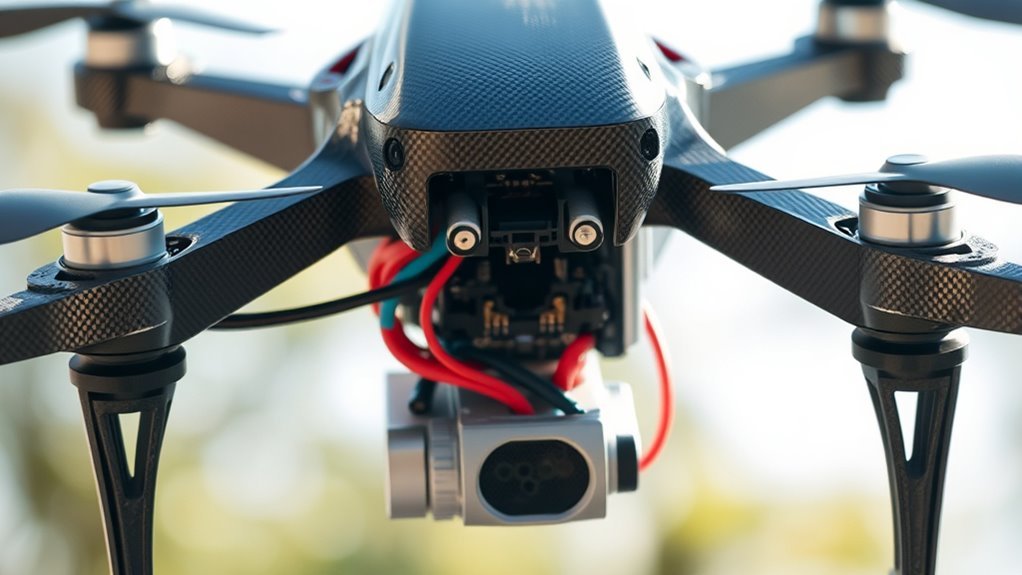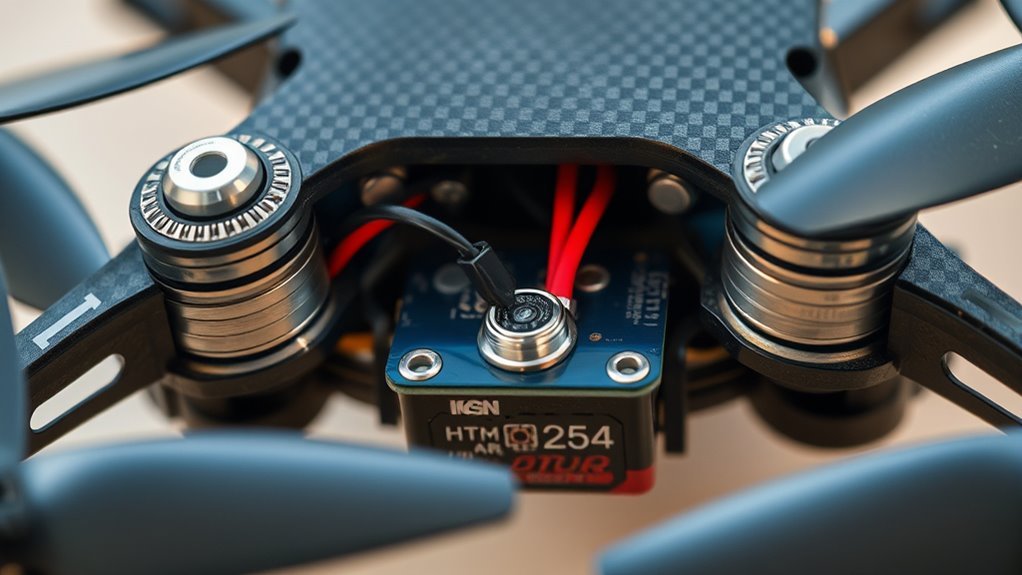Drones consist of several key components that work together to guarantee peak performance. The frame provides structural integrity, often made from lightweight materials like carbon fiber. Propellers generate lift, while brushless motors drive the flight capabilities. Electronic Speed Controllers manage power delivery, and the flight controller serves as the drone’s brain, processing data from various sensors. Communication is maintained through transmitters and receivers. Finally, sturdy landing gear guarantees stability during takeoffs and landings, setting the stage for further exploration of drone technology.
The Drone Frame: Structure and Design

When designing a drone, the frame serves as its backbone, providing essential structural integrity while influencing performance characteristics. You’ll find various frame materials, such as carbon fiber, aluminum, and plastic, each offering distinct advantages. Carbon fiber is lightweight and strong, enhancing flight efficiency, while aluminum provides durability at a slightly higher weight. Plastic frames, though less robust, can be cost-effective for beginners.
Moreover, design aesthetics play a significant role in your choice. A well-designed frame not only optimizes airflow but also enhances visual appeal, allowing for personal expression. When you combine appropriate frame materials with thoughtful design aesthetics, you create a drone that not only performs well but also resonates with your desire for freedom and individuality in flight. Additionally, high-quality materials, such as carbon fiber composites, contribute to impact resistance and the drone’s overall durability.
Propellers: The Power of Lift

The frame’s design and materials play a pivotal role in a drone’s overall performance, but the propellers are what truly generate lift and enable flight. Your choice of propeller materials—such as plastic, carbon fiber, or wood—affects durability and efficiency, impacting your drone’s range and responsiveness. Lighter materials can enhance agility, while sturdier options offer resilience against wear. Additionally, propeller sizes are critical; larger propellers typically produce more lift, but they may also create more drag. Finding the right balance between size and material is essential for peak performance. By understanding how these factors interact, you can customize your drone for various applications, whether it’s for racing, aerial photography, or recreational flight, allowing you the freedom to explore the skies. Moreover, the overall performance of a drone is significantly influenced by factors like battery life and stabilization technology, as seen in various models such as the Potensic Atom 2 and HoverAir X1 Pro. The efficiency of the battery design can greatly affect how long a drone remains airborne during its flight.
Motors: Driving Force Behind Flight

Understanding motor types is essential for optimizing drone performance, as each type offers distinct characteristics that affect efficiency and power output. You’ll find that the right motor not only enhances flight capabilities but also impacts battery life and overall weight. By evaluating these factors, you can make informed decisions for your drone’s design and functionality.
Motor Types Explained
While various components contribute to a drone’s flight capabilities, the motor type greatly influences performance and efficiency. Brushless motors are the preferred choice due to their superior motor efficiency and longevity compared to brushed alternatives. These motors generate higher motor torque, enabling better control and responsiveness, essential for agile maneuvers. Additionally, their design minimizes wear, enhancing motor lifespan, which translates to reduced maintenance and operational costs. When selecting a motor, consider factors such as weight, thrust-to-weight ratio, and power requirements to guarantee peak performance. Understanding these dynamics empowers you to make informed decisions, enhancing your flying experience and freedom in the skies. By prioritizing the right motor, you’ll markedly improve your drone’s overall capabilities and reliability.
Efficiency and Power Output
Efficient power output is essential for a drone’s performance, as it directly impacts flight duration and maneuverability. The motors serve as the driving force behind these capabilities, and their power efficiency is critical. By focusing on output optimization, you can guarantee that each motor generates maximum thrust while consuming minimal energy. This balance allows for extended flight times and agile responses to controls, enhancing your overall flying experience. Selecting high-quality brushless motors can greatly improve efficiency, as they typically offer better performance and durability. Additionally, understanding the relationship between battery capacity and motor power demands is fundamental for achieving ideal performance. Ultimately, prioritizing efficiency in your drone’s motors translates to greater freedom in the skies.
Electronic Speed Controllers: Managing Power
As drones rely heavily on their motors for flight, electronic speed controllers (ESCs) play an essential role in managing power delivery to these motors. They regulate the speed of the motors by modulating the power distribution based on your input commands. This speed regulation is vital for achieving precise control, particularly during maneuvers like ascents, descents, and turns. When you adjust your throttle, the ESC interprets these changes and adjusts the power supplied to the motors accordingly, ensuring peak performance. By efficiently managing the power flow, ESCs enhance battery life and improve responsiveness, giving you the freedom to explore aerial capabilities without compromise. Understanding how these components function helps you appreciate their importance in drone technology.
Flight Controller: The Brain of the Drone
The flight controller serves as the core processing unit of your drone, orchestrating its movements and stability. It integrates various sensors to monitor conditions and make real-time adjustments for ideal performance. Understanding these components is essential for enhancing your drone’s capabilities. Additionally, an efficient flight controller can significantly improve battery efficiency, allowing for longer flight times during your aerial adventures. Moreover, advancements in real-time data processing allow flight controllers to respond swiftly to dynamic changes in the environment, ensuring optimal performance.
Core Processing Unit
At the heart of every drone lies the flight controller, often referred to as its brain, which is crucial for managing all flight operations. The core processing unit of the flight controller executes critical core functions, including stabilization, navigation, and communication with other components. Its processing architecture determines how efficiently it can handle data inputs and outputs, ensuring smooth flight dynamics. You’ll find that advanced flight controllers leverage multi-core processors, enhancing their capability to process complex algorithms in real time. This architecture allows for rapid decision-making, enabling your drone to respond intuitively to various flight conditions. Ultimately, a well-designed core processing unit empowers you to explore the skies with precision and freedom, making it a significant component of any drone system.
Sensor Integration Features
Integrating sensors into the flight controller greatly enhances a drone’s operational capabilities. By utilizing various sensor types, you can achieve improved stability, navigation, and obstacle avoidance. Ensuring proper sensor calibration is essential to optimize performance and accuracy. Here’s a quick overview of common sensor types used in drones:
| Sensor Type | Purpose |
|---|---|
| IMU | Measures orientation and motion |
| GPS | Provides location data |
| LiDAR | Maps terrain and obstacles |
| Ultrasonic Sensor | Measures distance to objects |
Each sensor contributes to a more responsive and autonomous flight experience. By selecting the right sensors and calibrating them effectively, you reveal a drone’s full potential, allowing for greater freedom and versatility in various applications.
Battery: Fueling the Flight
Powering a drone’s flight hinges on the efficiency and capacity of its battery. You’ll encounter various battery types, each impacting performance and battery longevity. Lithium polymer (LiPo) batteries are popular for their high energy density, enabling longer flight times. However, you must consider the trade-offs, as they require careful handling and maintenance to maximize lifespan. Additionally, battery capacity directly limits flight time and travel distance on a single charge. Alternatively, lithium-ion batteries offer better longevity but may provide lower discharge rates. Understanding these distinctions helps you select the right power source for your drone’s specific needs. Ultimately, the choice of battery not only affects flight duration but also influences your drone’s agility and responsiveness, allowing you to fully embrace the freedom that aerial exploration provides. Additionally, proper battery management practices are essential to ensure optimal performance and longevity. Choose wisely to enhance your flight experience.
Sensors: Gathering Data for Navigation
In maneuvering effectively, drones rely on various types of sensors that gather critical data about their environment. You’ll need to understand how each sensor functions and the data processing techniques that convert raw input into actionable information. By grasping these concepts, you can enhance the operational efficiency of your drone. Additionally, integrating high-speed cameras into the drone’s system can significantly improve situational awareness by capturing rapid movements in real-time.
Types of Sensors
Sensors are the eyes and ears of a drone, essential for gathering data necessary for effective navigation. Among the various types, Lidar technology stands out for its precision in mapping and obstacle detection. Infrared sensors are vital for thermal imaging, helping you identify heat signatures in your environment. Ultrasonic sensors measure distance through sound waves, enabling safe altitude management. GPS modules provide accurate positioning data, allowing for autonomous flight paths and navigation. Finally, optical flow sensors analyze the movement of the ground relative to the drone, enhancing stability and control. Together, these sensors create a thorough system that empowers drones to navigate complex environments with agility and precision, giving you the freedom to explore without limits.
Sensor Functionality Explained
Understanding how sensors function is key to maximizing a drone’s navigational capabilities. Sensors gather real-time data, enabling your drone to navigate complex environments. To guarantee accuracy, it’s essential to implement effective sensor calibration techniques. These methods optimize sensor readings, reducing deviations that could lead to navigation errors.
Additionally, employing sensor fusion methods can greatly enhance your drone’s operational efficiency. By integrating data from multiple sensors, you create a thorough understanding of the surroundings, allowing for more precise navigation decisions. This synergy not only improves obstacle detection but also aids in maintaining stability during flight. Ultimately, mastering these functionalities empowers you to harness the full potential of your drone, granting you the freedom to explore and operate with confidence.
Data Processing Techniques
When it comes to navigation, effective data processing techniques are vital for interpreting the vast amounts of information collected by your drone’s sensors. Utilizing advanced data analysis methods, you can extract valuable insights from sensor data, enabling precise navigation. Algorithms play an important role in this process, continuously optimizing to enhance performance. By implementing algorithm optimization, you guarantee that your drone can quickly adapt to changing environments, avoiding obstacles and maintaining stability. Machine learning techniques can further refine these algorithms, allowing your drone to learn from past flights and improve future performance. Ultimately, mastering these data processing techniques frees you to explore with confidence, knowing your drone can navigate efficiently and safely through complex terrains.
Camera Systems: Capturing Aerial Views
In the world of drone technology, camera systems play a pivotal role in capturing stunning aerial views. High camera resolution is essential for producing clear, detailed images, allowing you to explore landscapes from unique perspectives. When selecting a drone for aerial photography, consider the types of sensors and lenses that enhance image quality and versatility. Many drones now feature advanced gyroscopic and electronic stabilization technology, ensuring smooth footage even in windy conditions. Additionally, adjustable settings for shutter speed and ISO can help you adapt to varying light conditions, maximizing your creative potential. As you navigate the skies, a robust camera system empowers you to document your adventures, providing a sense of freedom as you capture breathtaking visuals from above. Notably, image stabilization techniques are crucial in enhancing the quality of footage and minimizing blurriness during flight.
Transmitters and Receivers: Communication Links
The effectiveness of drone operations heavily relies on reliable transmitters and receivers, which serve as the critical communication links between the pilot and the aircraft. These components guarantee that commands are transmitted swiftly and accurately, maintaining control over the drone. Antenna design plays a pivotal role here, as it directly impacts the signal range and quality. Ideal antenna configurations can extend the communication distance while minimizing interference.
| Component Type | Function |
|---|---|
| Transmitter | Sends control signals |
| Receiver | Receives data from the drone |
| Antenna | Enhances signal range |
Understanding these elements is essential for maximizing your drone’s operational capabilities, allowing you to explore freely without interruptions.
Landing Gear: Safety and Stability During Landings
Effective communication between the pilot and drone is only part of ensuring safe operations; equally important is the landing gear, which provides stability and safety during landings. When choosing landing gear materials, consider durability and weight—common options include carbon fiber, aluminum, and plastic composites. Each material has distinct advantages, affecting both performance and cost.
Landing gear designs vary widely; they can be fixed, retractable, or even skids, depending on the drone’s purpose. A well-engineered design enhances landing precision, reducing the risk of damage during descent. By understanding these factors, you can select a landing gear setup that aligns with your operational needs, ensuring your drone’s freedom to maneuver without compromising safety upon landing. Additionally, the Draganfly Commander 2 demonstrates how robust landing gear can enhance overall flight performance and durability in challenging conditions. Drones like the Asylon DroneSentinel exemplify the importance of durable materials by utilizing carbon fiber and aluminum for enhanced stability.
Frequently Asked Questions
How Do I Choose the Right Drone Components for My Needs?
Choosing the right drone components is like crafting a masterpiece. You’ll need to guarantee the drone specifications align perfectly, and that component compatibility is rock-solid. Dive deep into manuals to release your aerial freedom!
Can I Upgrade Individual Components in My Drone?
Yes, you can upgrade individual components in your drone, but guarantee component compatibility to avoid performance issues. Upgrading parts can enhance your drone’s capabilities, providing the freedom to tailor it to your specific needs and preferences.
What Materials Are Used in Drone Construction?
Imagine a bird gliding through the sky; drones are crafted from materials like carbon fiber for strength and lightweight aluminum alloys for durability. These choices enhance performance, ensuring you experience freedom in flight.
How Do Weather Conditions Affect Drone Components?
Weather conditions greatly influence drone performance. Temperature effects can lead to battery efficiency loss, while humidity impact may cause sensor malfunctions. Understanding these factors guarantees you maintain ideal functionality and reliability during flight operations.
Are Drone Components Interchangeable Between Different Models?
Like a puzzle, drone components aren’t always interchangeable. Component compatibility varies across models due to unique designs and specifications. Understanding these model variations can empower you to optimize performance and enhance your flying experience.

